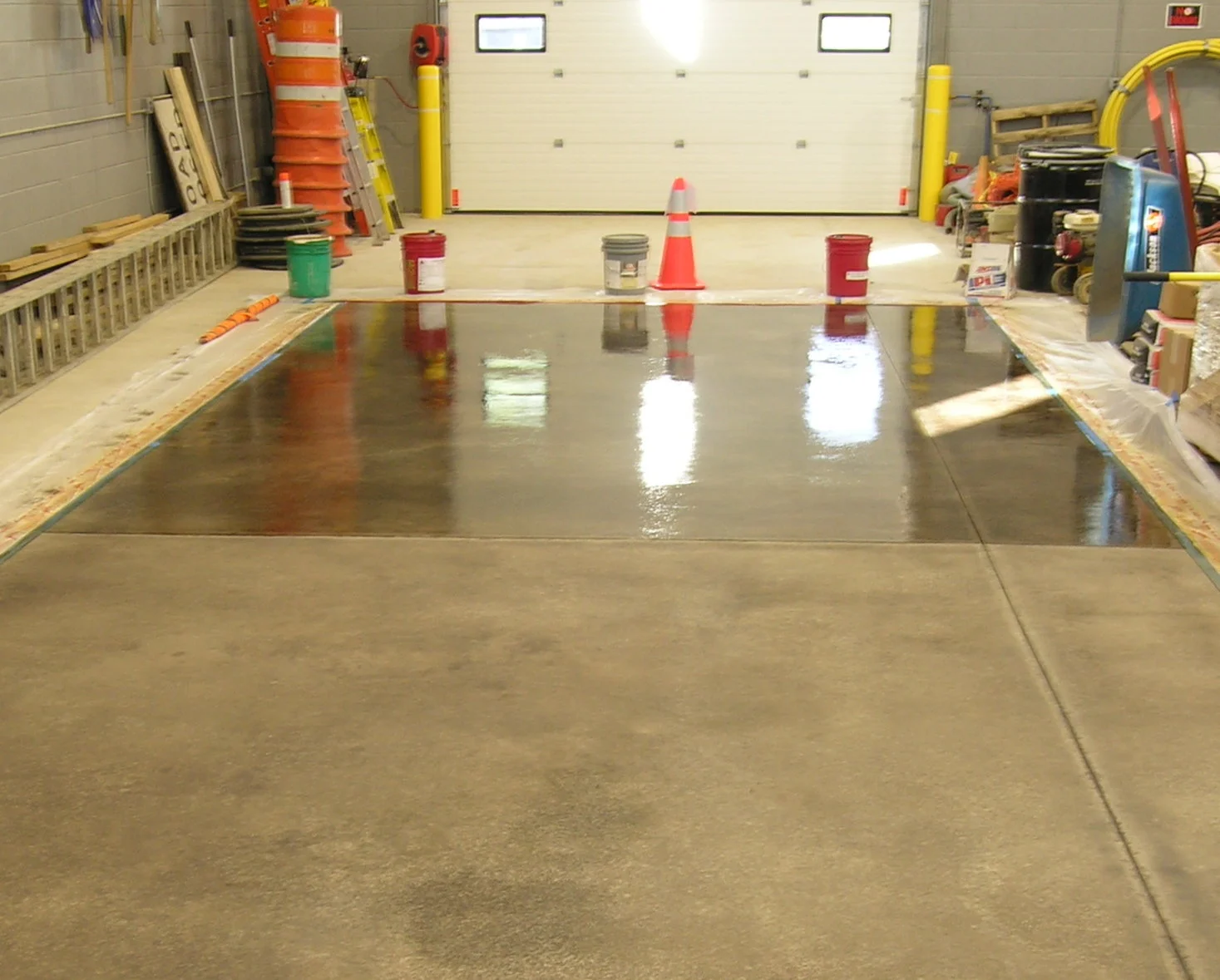CLEAR Sealers
This warehouse concrete floor "bay" was acid-stained to protect it from oil spills and stains during equipment maintenance. Above, a clear polyurea sealer is being applied to deepen the color of the stain and add a hard, durable, protective glossy film.
A clear sealer is required for every acid-stained concrete flooring project. Most importantly, the clear sealer brings out the true color of the stained concrete (see photo right). Without it, the color of the floor would be pale and flat. Next, the clear sealer protects the concrete surface from moisture, spills, staining, dirt, and scratches and abrasion, thereby preserving the color. An acid-stained concrete floor with no sealer would eventually lose, or have discolored, much of its original coloring due to foot traffic. Thirdly, the clear sealer makes maintenance easier. Dust comes up readily, and wax or floor finish can be applied, burnished, removed and reapplied, without affecting the basic appearance of the floor. Lastly, the clear sealer adds depth, luster and gloss to acid-stained concrete, drawing greater attention to, and enhancing, its fundamental elegance and beauty.
There are four main types of sealers used on acid-stained concrete flooring: 1) acrylics; 2) epoxies; 3) urethanes; and 4) polyureas. Each type of sealer performs the major functions listed above, to varying degrees. The basic differences between these sealers are durability and expense. Acrylics are the least durable and most affordable, while polyureas are the most durable and most expensive. Epoxies and urethanes fall somewhere in between, depending on their formulation, the main advantages of epoxies being toughness and adhesion, and those of urethanes, being chemical, UV, and scratch-resistance. Acrylic sealers are sufficiently durable for floors in most homes, while epoxies and urethanes are almost always required for business settings. Polyureas are best reserved for harsh environments, such as warehouses, garage floors, and hair salons, although they can be used in commercial facilities as a way of easing maintenance.
One of the very best sealers on the market today for acid-stained concrete and other types of decorative concrete flooring is the "polyurea". Polyurea is extremely durable, long-lasting and easy to maintain.
Most clear sealers for concrete come in water and solvent-based versions. Contractors tend to favor solvent-based sealers because they are easier to apply, and fix, if necessary, while homeowners and businesses prefer water-based sealers because they are odorless and safer to use. But water and solvent based sealers are also chosen for their color enhancement properties. Solvent-based sealers significantly deepen the color of stained concrete, whereas water-based sealers enhance color only slightly. As a result, the choice of sealer can result in two completely different shades or "tones" of the same color of concrete stain. We work with each and every customer to choose the clear sealer that best suits their project environment, fits their budget parameters, and achieves the optimal color enhancement and gloss. To do this, we perform stained and sealed color samples at the outset of every stained concrete flooring project.
It should be noted that there are several types of "leading-edge", clear concrete sealers on the market that contain no water or solvent whatsoever, but rather are composed entirely of resin solids. These generally fall in the categories of epoxies, polyureas and "polysiloxanes", which are an organic-inorganic, "hybrid" coating. The main advantage of these 100%-solids, clear concrete sealers, in addition to extremely low odor and high durability, is their very short cure time, and quick return to service of the floor.
HIGH-PERFORMANCE COLORED COATINGS
A high performance colored coating system from the Ameron Corporation, owned by PPG, was used on this parking deck stairwell in Troy, MI.
In addition to clear sealers for decorative concrete, there is also a distinct market, in the today's concrete flooring industry, for high-performance colored coatings. This market exists because certain end users want something that is less expensive and fundamentally more functional than stained concrete flooring and other forms of decorative concrete, like polished concrete. It might be a laboratory, school, hospital, restaurant kitchen, warehouse, garage, or repair facility. The technologies used for these colored coatings are basically the same as those used for clear concrete sealers (above), except for acrylic. They consist of: 1) epoxies; 2) urethanes; 3) polyureas; 4) 100% solids; and 5) polysiloxanes, and are manufactured and sold by large companies like Sherwin Williams, PPG, Akzo Nobel, Tnemec, Covestro and Rustoleum. The primary difference with high-performance colored coatings is that pigment has been added. Sometimes, clear sealers are used on top of high-performance colored coatings so that any damage to the floor, like scratches, does not reach, or affect, the color.
A gray-tinted, polyurea coating from Citadel Systems was used to coat this two-car garage floor, after resurfacing it with a thin cement overlay.
One important note about all clear concrete sealers and high-performance colored coatings: In general, the coatings technologies used for these products match or exceed the slip-resistance of other forms of hard or resilient flooring, like ceramic tile, VCT, laminate and hardwood. However, some of the most durable sealers and coatings, particularly polyureas and polysiloxanes, do become slippery when wet, and require a non-slip additive during application. Premier Veneers uses several sizes and varieties of non-slip additives, like glass bead, on our flooring projects involving polyurea sealers or coatings, that are very effective yet, at the same time, inconspicuous or invisible. Sealers and coatings based on acrylic, epoxy or urethane can also be slippery when wet. Instead of a non-slip additive, with these coating technologies, waxes and floor finishes are used to provide greater traction. Premier Veneers installs high-performance colored coatings from Citadel Floor Finishing Systems, which is owned by Rustoleum. In our opinion, they make the best high-performance color coatings on the market. We also use Citadel’s clear sealers.




